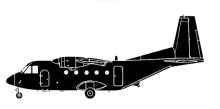
ASN Wikibase Occurrence # 321061
| Date: | Friday 2 September 2011 |
| Time: | 17:48 |
| Type: |  CASA C-212 Aviocar 300DF |
| Owner/operator: | Fuerza Aérea de Chile |
| Registration: | 966 |
| MSN: | 443 |
| Year of manufacture: | 1994 |
| Fatalities: | Fatalities: 21 / Occupants: 21 |
| Aircraft damage: | Destroyed, written off |
| Category: | Accident |
| Location: | off Isla Robinsón Crusoe Airport -
 Chile Chile
|
| Phase: | Approach |
| Nature: | Military |
| Departure airport: | Santiago-Arturo Merino Benitez Airport (SCL/SCEL) |
| Isla Robinsón Crusoe Airport (SCIR) | |
| Confidence Rating: |
A CASA C-212 Aviocar transport plane, operated by the Chilean Air Force, was destroyed when it crashed into the sea while on approach to Isla Robinsón Crusoe Airport.
The airplane had left Santiago (SCL) at 13:52 on a flight to Isla Robinsón Crusoe, one of the islands of the Juan Fernández archipelago. On the plane was a team from Televisión Nacional de Chile, members of NGOs, officials of the Council of Culture and staff of the Chilean Air Force. They were going to visit the islands to see the progress of relief activities following the 2010 earthquake.
The aircraft finally took off at 16:51 UTC (13:51 local). The flight enroute encountered adverse weather conditions: a strong permanent headwind with varying intensity, numerous clouds, and storms that forced major changes in heading and flight level, with the aircraft climbing up to FL150 versus the FL090 authorized level.
The aircraft arrived at the island at 19:48 UTC, after a two hour and 57 minute flight. A local representative was waiting on the airfield to welcome the aircraft and passengers. He observed that the aircraft flew over runway 14 (north to south) and performed a teardrop maneuver to the right to an invert heading approaching to runway 32. When the aircraft was on the runway 32 heading, a balked landing was experienced with high and gusty crosswinds, with the aircraft deviating to the right of the runway.
An open left turn for a new approach to runway 32 was initiated through the channel between the airfield and Santa Clara Island; but the aircraft disappeared below the hills around the airport, and it was never seen again.
Investigators concluded that the aircraft struck the ocean in an abnormal attitude with a bank angle significantly past a 90-degree left bank. The aircraft was inverted and still rolling to the left while side slipping to the left. The break-up sequence shows the aircraft was flying forward, but it was also quickly side slipping to the left.
The aircraft nose was also dropping; however, the aircraft did not cartwheel. It rolled inverted while the outer portion of the left wing was slicing into the water and literally shattering from water forces.
At the same time, the aircraft nose and cockpit were destroyed when they impacted the water and rotated some 30 degrees to the right while being crushed rearward by water forces.
When the aircraft rolled totally inverted, the right wing slammed into the ocean and broke into three large sections. The top of the fuselage was rippled like an accordion by water friction forces, and the rear fuselage and dorsal fin displayed hydraulic crushing on the right side.
Investigators concluded that the accident was caused by the loss of control of the airplane while performing the tailwind leg through the channel between the islands of Robinson Crusoe and Santa Clara to an estimated height of 650 feet or less, during the circuit approach to Runway 32 in a very low trajectory (with little height difference above the runway), where very adverse airflow conditions were found, including wind shear, which exposed the crew to extreme flight conditions.
Adverse airflow conditions were the results of a combination of different factors, including
- very unstable atmosphere, with strong turbulence and possibly eventually powerful down gusts arising from the presence of open cells after a front passed.
- the presence of the two counter-rotating vortexes in the Santa Clara Island downwind wake.
- the presence of strong and gusty crosswinds that were very variable in strength and direction in a very short time.
Sources:
FACh press releases
Links for a Successful Investigation: C-212 Robinson Crusoe Island Accident Case / By Luis Gracia (ISASI Forum April-June 2017)
Location
Revision history:
| Date/time | Contributor | Updates |
|---|
The Aviation Safety Network is an exclusive service provided by:


 ©2024 Flight Safety Foundation
©2024 Flight Safety Foundation